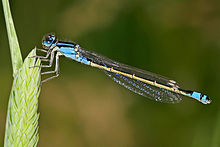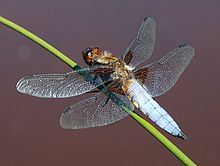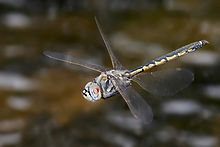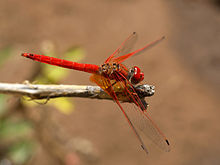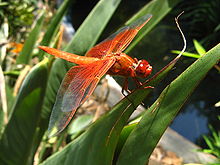- Dragonfly
-
This article is about the insect. For other uses, see Dragonfly (disambiguation)."Anisoptera" redirects here. For other uses, see Anisoptera (disambiguation).
Dragonfly 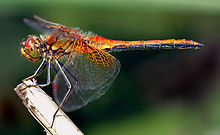
Yellow-winged Darter Scientific classification 
Kingdom: Animalia Phylum: Arthropoda Class: Insecta Order: Odonata Suborder: Epiprocta Infraorder: Anisoptera
Selys, 1854Families - Aeshnidae
- Austropetaliidae
- Chlorogomphidae
- Cordulegastridae
- Corduliidae
- Gomphidae
- Libellulidae
- Macromiidae
- Neopetaliidae
- Petaluridae
- Synthemistidae
A dragonfly is a winged insect belonging to the order Odonata, the suborder Epiprocta or, in the strict sense, the infraorder Anisoptera (from Greek ανισος anisos, "uneven" + πτερος pteros, "wings", due the hindwing being broader than the forewing[1]). It is characterized by large multifaceted eyes, two pairs of strong transparent wings, and an elongated body. Dragonflies are similar to damselflies, but the adults can be differentiated by the fact that the wings of most dragonflies are held away from, and perpendicular to, the body when at rest. Dragonflies possess six legs (like any other insect), but most of them cannot walk well. Dragonflies are some of the fastest insects in the world.
Dragonflies are valuable predators that eat mosquitoes, and other small insects like flies, bees, ants, wasps, and very rarely butterflies. They are usually found around marshes, lakes, ponds, streams, and wetlands because their larvae, known as "nymphs", are aquatic.
Contents
Classification (Anisozygoptera)
Formerly, the Anisoptera were given suborder rank beside the "ancient dragonflies" (Anisozygoptera) which were believed to contain the two living species of the genus Epiophlebia and numerous fossil ones. More recently it turned out that the "anisozygopterans" form a paraphyletic assemblage of morphologically primitive relatives of the Anisoptera. Thus, the Anisoptera (true dragonflies) are reduced to an infraorder in the new suborder Epiprocta (dragonflies in general). The artificial grouping Anisozygoptera is disbanded, its members being largely recognized as extinct offshoots at various stages of dragonfly evolution. The two living species formerly placed there — the Asian relict dragonflies — form the infraorder Epiophlebioptera alongside Anisoptera.
Flight speed
Tillyard claimed to have recorded the Southern Giant Darner flying at nearly 60 miles per hour (97 km/h) in a rough field measurement.[2] However, the greatest reliable flight speed records are for other types of insects.[3] In general, large dragonflies like the hawkers have a maximum speed of 10–15 metres per second (22–34 mph) with average cruising speed of about 4.5 metres per second (10 mph).[4]
Dragonflies and damselflies
Damselflies (suborder Zygoptera), typically being smaller than dragonflies, are sometimes confused with newly moulted dragonflies. However, once a dragonfly moults, it is already fully grown. There are other distinctions that set them apart: most damselflies hold their wings at rest together above the torso or held slightly open above (such as in the family Lestidae), whereas most dragonflies at rest hold their wings perpendicular to their body, horizontally or occasionally slightly down and forward. Also, the back wing of the dragonfly broadens near the base, caudal to the connecting point at the body, while the back wing of the damselfly is similar to the front wing. The eyes on a damselfly are apart; in most dragonflies the eyes touch. Notable exceptions are the Petaluridae (Petaltails) and the Gomphidae (Clubtails).
The largest living odonate by wingspan is actually a damselfly from South America, Megaloprepus caerulatus (Drury, 1782) while the second largest are females of the dragonfly Tetracanthagyna plagiata (Wilson, 2009). The female T. plagiata is probably the heaviest living odonate.[5]
Common species
Northern hemisphere
- Emperor, Anax imperator
- Keeled Skimmer, Orthetrum coerulescens
- Black-tailed Skimmer, Orthetrum cancellatum
- Common Whitetail, Libellula lydia
- Migrant Hawker, Aeshna mixta
- Azure Hawker, Aeshna caerulea
- Southern Hawker, Aeshna cyanea
- Norfolk Hawker, Aeshna isosceles
- Common Hawker, Aeshna juncea
- Red-veined Darter, Sympetrum fonscolombii
- Common Darter, Sympetrum striolatum
- Vagrant Darter, Sympetrum vulgatum
- Yellow-winged Darter, Sympetrum flaveolum
- Broad-bodied Chaser, Libellula depressa
- Four-spotted Chaser, Libellula quadrimaculata
- Scarce Chaser, Libellula fulva
- Green Darner, Anax junius
- Downy Emerald, Cordulia aenea
- Blue-eyed Darner, Aeshna multicolor
- Roseate Skimmer, Orthemis ferruginea
- Widow Skimmer, Libellula luctuosa
- Great Pondhawk, Erythemis vesiculosa
- Comet Darner, Anax longipes
- Banded Pennant, Celithemis fasciata
- Texas Emerald, Somatochlora margarita
Southern hemisphere
- Orange Emperor Anax speratus
- Common Thorntail Ceratogomphus pictus
- Southern Yellowjack Notogomphus praetorius
- Ivory Pintail Acisoma trifidum
- Banded Groundling Brachythemis leucosticta
- Broad Scarlet Crocothemis erythraea
- Little Scarlet Crocothemis sanguinolenta
- Black Percher Diplacodes lefebvrii
- Black-tailed False-skimmer Nesciothemis farinosa
- Two-striped Skimmer Orthetrum caffrum
- Epaulet Skimmer Orthetrum chrysostigma
- Julia Skimmer Orthetrum julia
- Navy Dropwing Trithemis furva
- Kirby's Dropwing Trithemis kirbyi
- Jaunty Dropwing Trithemis stictica
Dragonflies in cultures
In Europe, dragonflies have often been seen as sinister. Some English vernacular names, such as "devil's darning needle" and "ear cutter", link them with evil or injury.[6] A Romanian folk tale says that the dragonfly was once a horse possessed by the devil. Swedish folklore holds that the devil uses dragonflies to weigh people's souls.[7]:25–27 The Norwegian name for dragonflies is "Øyenstikker", which literally means Eye Poker and in Portugal they are sometimes called "tira-olhos" (Eye snatcher). They are often associated with snakes, as in the Welsh name gwas-y-neidr, "adder's servant".[6] The Southern United States term "snake doctor" refers to a folk belief that dragonflies follow snakes around and stitch them back together if they are injured.[8]
For some Native American tribes they represent swiftness and activity, and for the Navajo they symbolize pure water. Dragonflies are a common motif in Zuni pottery; stylized as a double-barred cross, they appear in Hopi rock art and on Pueblo necklaces.[7]:20–26
They have also been used in traditional medicine in Japan and China. In some parts of the world they are a food source, eaten either as adults or larvae; in Indonesia, for example, they are caught on poles made sticky with birdlime, then fried in oil as a delicacy.[6]
In the United States dragonflies and damselflies are sought out as a hobby similar to birding and butterflying, known as oding, from the dragonfly's Latin species name, odonata. Oding is especially popular in Texas, where 225 different species of odonates have been observed. With care, and with dry fingers, dragonflies can be handled and released by oders, as can be done with butterflies, though it is not encouraged.[9]
Images of dragonflies are common in Art Nouveau, especially in jewelry designs.[10] They also appear in posters by modern artists such as Maeve Harris.[11] They have also been used as a decorative motif on fabrics and home furnishings.[12] Douglas, a British motorcycle manufacturer based in Bristol, named their innovatively designed post-war 350cc flat twin model, the Dragonfly.
Japan
As a seasonal symbol in Japan, the dragonfly is associated with early and late summer and early autumn.[13]
More generally, in Japan dragonflies are symbols of courage, strength, and happiness, and they often appear in art and literature, especially haiku. The love for dragonflies is reflected in the fact that there are traditional names for almost all of the 200 species of dragonflies found in and around Japan.[14] Japanese children catch large dragonflies as a game, using a hair with a small pebble tied to each end, which they throw into the air. The dragonfly mistakes the pebbles for prey, gets tangled in the hair, and is dragged to the ground by the weight.[7]:38
As it symbolizes courage, boys are given the name of "Tonbo", meaning dragonfly. The shape of the archipelago of Japan, as seen on a map, is said to be that of a dragonfly. Hence the leading male character in Kiki's Delivery Service, in a non-Japanese setting, is named "Tonbo" so that the Japanese audience can identify him.
Beyond this one of Japan's former names – あきつしま (Akitsushima) – is literally an archaic form of Dragonfly Island(s).[15] This is attributed to a legend in which Japan's mythical founder, Emperor Jinmu, was bitten by a mosquito, which was then promptly eaten by a dragonfly.[16][17]
See also
- Aeshnoidea
- Cordulegastroidea
- Elliot Pinhey
- Libelluloidea
- List of British dragonflies
- Obelisk posture
References
- ^ Odonata at Tree of Life web project. Retrieved 2011-09-18.
- ^ Tillyard, Robert John (1917). The Biology of Dragonflies. pp. 322–323. http://medusa.jcu.edu.au/odonata_digital_literature/Tillyard/tillyard_1917_book_searchable.pdf. Retrieved 15 December 2010. "I doubt if any greater speed than this occurs amongst Odonata"
- ^ T. J. Dean (2003-05-01). "Chapter 1 — Fastest Flyer". Book of Insect Records. University of Florida. http://www.entnemdept.ufl.edu/walker/ufbir/chapters/chapter_01.shtml.
- ^ "Frequently Asked Questions about Dragonflies". British Dragonfly Society. http://www.british-dragonflies.org.uk/content/frequently-asked-questions. Retrieved 5 July 2011.
- ^ T. M. Leong, S. L. Tay (2009). "Encounters with Tetracanthagyna plagiata (Waterhouse) in Singapore, with an Observation of Oviposition". Nature In Singapore (National University of Singapore) 2: 115–119. http://rmbr.nus.edu.sg/nis/bulletin2009/2009nis115-119.pdf. Retrieved 14 December 2010.
- ^ a b c Corbet, Phillip S. (1999). Dragonflies: Behavior and Ecology of Odonata. Ithaca, NY: Cornell University Press. pp. 559–561. ISBN 0-8014-2592-1.
- ^ a b c Mitchell, Forrest L.; James L. Lasswell (2005). A Dazzle of Dragonflies. College Station, TX: Texas A&M University Press. ISBN 1-585-44459-6.
- ^ Hand, Wayland D. (1973). "From Idea to Word: Folk Beliefs and Customs Underlying Folk Speech". American Speech 48 (1/2): 67–76. doi:10.2307/3087894. JSTOR 3087894.
- ^ Tracy Hobson Lehmann (June 19, 2008). "Dragonflying: the new birding". San Antonio Express-News.
- ^ Moonan, Wendy (August 13, 1999). "Dragonflies Shimmering as Jewelry". New York Times: pp. E2:38. ProQuest document ID 43893085.
- ^ "The Maeve Harris category contains 37 items". AllPosters.com. 2009-09-18. http://www.allposters.com/gallery.asp?aid=470111166&c=c&search=41107&DestType=12&Referrer%20=http://www.google.com/search?hl=en&safe=off&client=firefox-a&rls=com.ubuntu%3Aen-US%3Aunofficial&hs=&KWID=17261181&KEYWORD=Maeve+Harris&SEM=lang%3D1%26c%3Dc%26search%3D41107%26AID%3D470111166%26KWID%3D17261181%26Keyword%3DMaeve%2BHarris. Retrieved 2009-09-18.
- ^ Large, Elizabeth (June 27, 1999). "The latest buzz; In the world of design, dragonflies are flying high". The Sun (Baltimore, MD): pp. 6N. ProQuest document ID 42880564.
- ^ Baird, Merrily (2001). Symbols of Japan: Thematic Motifs in Art and Design. New York: Rizzoli. pp. 108–9. ISBN 0-8478-2361-X.
- ^ Waldbauer, Gilbert (1998). The Handy Bug Answer Book. Detroit: Visible Ink Press. pp. 91. ISBN 1-57859-049-3.
- ^ Nussbaum, Louis Frédéric et al. (2005). "Akitsushima" in Japan encyclopedia, p. 20. at Google Books
- ^ Nihonto
- ^ 杉浦 (Sugiura), 洋一 (Youichi); ジョン・K・ギレスピー (John K. Gillespie) (1999) (in Japanese & English). 日本文化を英語で紹介する事典: A Bilingual Handbook on Japanese Culture. 日本国東京都千代田区 (Chiyoda, JP-13): 株式会社ナツメ社 (Kabushiki gaisha Natsume Group). p. 305. ISBN 4-8163-2646-4. http://www.natsume.co.jp. Retrieved 2010-04-26.
External links
- Tree of Life Odonata
- Dragonfly at the Open Directory Project
- Identification key to dragonflies found in Ireland
- British Dragonfly Society
- Dragonflies and Damselflies (Odonata) of the United States
- Phaon (Pinhey's Heritage African Odonata Network)
- Dragonflies and damselflies on the UF / IFAS Featured Creatures Web site
- Photos of dragonflies from Asia-dragonfly.net, Africa-dragonfly.net, America-Dragonfly.net, Libellulasman.com and Odonata.su
- list of field guides to dragonflies, from the International Field Guides Database
Categories:- Odonata
- Dragonflies
- Living fossils
- Biological pest control agents
Wikimedia Foundation. 2010.

